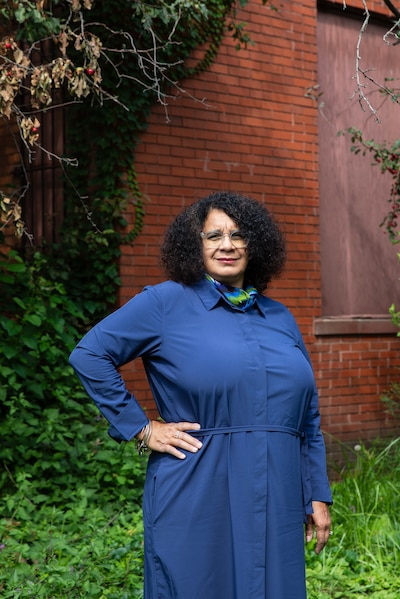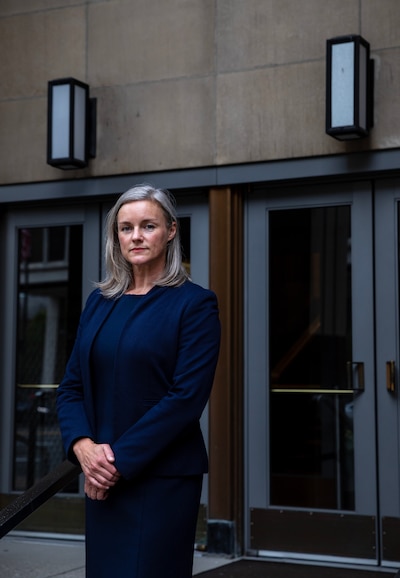Sign up for Chalkbeat Detroit’s free daily newsletter to keep up with the city’s public school system and Michigan education policy.
In the books she read growing up, Nancy Jennings saw a lot of school buses cruising across the pages. She had always wanted to ride in one, but Jennings lived just a few blocks from her neighborhood school in southwest Detroit so she usually walked to class.
When Jennings finally got the chance to step foot on a bus, her 10-year-old mind had no idea just how significant the moment was.
In January 1976, Jennings, who is biracial, was among the students in Detroit bused to desegregate public schools.

At the time, Detroit’s classrooms were becoming increasingly segregated. Racist practices – such as restrictive covenants that prevented Black residents from buying or leasing property, and policies that denied them housing loans – created and maintained segregated neighborhoods. White residents were fleeing the city for the suburbs, in part because of the 1967 Detroit uprising, a violent rebellion in response to the systemic racism and police brutality Black residents faced.
Jennings’ bus ride, from one part of the city to another, wouldn’t change the trajectory of school segregation in metro Detroit. A landmark ruling by the U.S. Supreme Court just two years before had drastically limited what could be done to address segregated schools. In Milliken v. Bradley, the court ruled 5-4 that suburban districts were not responsible for school segregation in Detroit and could not be forced to be part of the remedy. The decision ended the possibility of cross-district busing.
The ruling, which came 50 years ago this month, has had profound and lasting effects on segregated classrooms in Detroit and across the country. Legal scholars say it eroded the progress made after Brown v. Board of Education, another landmark court decision that declared in 1954 that state-mandated racial segregation in schools was unconstitutional.
Many social scientists who study educational equity lament the decision in Milliken to this day. They believe this type of court-ordered desegregation policy was a necessary solution for segregated schools, a persistent problem that often leaves students and teachers with fewer resources.
Leanne Kang, a professor at Grand Valley State University, said the ruling “was the nail in the coffin” for the nation’s progress toward school integration.
Busing opposition stretched across several divides
On Jan. 26, 1976, a cloudy, 36-degree day, the bus that 10-year-old Jennings stepped onto took her away from her familiar school, where the majority of her classmates were Black, to a mostly white school in the southwest Detroit Delray neighborhood.
It was just four miles from her old school, but it seemed a continent away.
“The kids I was interacting with felt different, not because they were white,” said Jennings, whose father was white and mother was Black. Rather, it was because a lot of them were in need, she said.
Delray is near Zug Island, where, at the turn of the 19th century, industry polluters began wreaking havoc on the environment, contaminating the air and soil in the name of iron and steel production. Many residents have long struggled with poverty and continue to face health problems from a toxic legacy of pollution.
Jennings’ parents weren’t happy about the order to bus their daughter to another school – sentiments shared by many other parents in Detroit.
There was plenty of opposition to busing at the time, including the idea of a cross-district plan, said Ken Coleman, Detroit historian and journalist.
Resistance came from both white and Black residents – some white people didn’t want their children bused to predominantly Black classrooms, while some Black people feared busing would diminish community control of schools.
Pontiac resident Irene McCabe, who was white, took her anti-busing campaign, related to a separate busing order in that city, to Washington D.C., and L. Brooks Patterson, the late prosecutor and former executive of Oakland County, acted as McCabe’s attorney. Patterson was himself outspoken against integration — one seed of many that rooted his racist legacy in southeastern Michigan.
Some of Detroit’s Black leaders, such as then-state senator and former Detroit Mayor Coleman Young, also pushed back against cross-district busing.
“Coleman Young and others believed that the remedy wasn’t really about Black kids going to school with white kids in the suburbs,” Coleman said.
For some Black activists, the answer was parity — giving kids from the lower east side of Detroit the same resources as those given to kids in West Bloomfield, Pontiac, and other communities, Coleman said.
Families across racial and ethnic lines also were concerned about the unknown — putting their kids on a bus and sending them across town to a completely new classroom, where they could be bullied or harassed.
At the time, 1 in 5 Detroit residents supported the city busing order that went into effect following the Supreme Court ruling, according to a 1976 survey conducted by the Detroit Free Press. But the survey failed to capture how a lot of parents felt. The Free Press wrote that 70% of respondents did not have children under the age of 18 and 80% did not have kids in Detroit schools.
In the Jennings’ household, Nancy’s parents thought about sending her to a private school. They decided it was too expensive, though, so she stayed enrolled in the under-resourced school in a poorer part of town.
From her 10-year-old perch, Jennings caught whiffs of the social climate — anti-busing protests on the television screen and dramatic newspaper headlines – but it would take her many years to understand the significance of her experience.
Former Detroit police officer Dale Seaton grew up in a southwest Detroit neighborhood not far from Jennings, and he remembers being bused from his mostly Black school to what is now Clippert Multicultural Magnet Academy, which was predominantly Hispanic then and remains so today.
The addition of 12-year-old Seaton, who is Black, and his classmates shifted the racial makeup of Clippert, making it half Black and half Hispanic for a time, he said. It was a deeply formative experience for Seaton, whose father, a teacher, pushed him to be part of Detroit’s busing experiment.

The students he rode the bus with “became my lifetime friends, because their parents were much like my parents — they saw an opportunity. So I had like-minded kids on the bus with me … literally everybody that’s on that bus, I’m still friends with.”
Seaton eventually returned to Clippert as a substitute teacher, where he understood the weight of his presence in the classroom — fewer than 2% of teachers nationwide are Black men.
Unearthing the deep roots of Milliken v. Bradley
Matthew Kautz, a professor at Eastern Michigan University, sees major and lasting impacts from the Milliken case, from the inequitable state funding Detroit schools receive in comparison to other districts to the state’s history of meddling in the management of the district.
The district also remains predominantly Black.
Kautz traces the origins of Milliken v. Bradley to the Great Migration that began in the 1910s and lasted through the 1970s, when Black Americans moved to Rust Belt cities like Detroit and other parts of the country to escape the racial violence and systemic racism wrought by the South’s Jim Crow laws, which enforced segregation and marginalized Black citizens.
As more Black people moved into Detroit, white residents fled, and city officials continued to redraw the city’s border lines to reinforce segregation, Kautz said.
By the 1950s and 1960s, state officials were playing a more active role in administering federal funds for housing – and also meddling in changing school district lines, something U.S. District Judge Stephen Roth found in his opinion for the lower court in Milliken v. Bradley, Kautz noted.
Meanwhile, a battle for community control and school decentralization was taking shape in the halls of power.
Coleman Young, then a state legislator, helped push through Public Act 48, which decentralized the Detroit school system. The law was in response to the passage of a Detroit Board of Education desegregation plan.
“All of these factors become part of the reason why the NAACP doesn’t just sue the city but also the state, with Governor Milliken becoming identified in the case,” Kautz said.
The NAACP presented evidence in Roth’s courtroom that showed how the state was facilitating residential and educational segregation. And so Roth “opens the door for the metropolitan desegregation plan — the idea that Detroit and 53 of its contiguous suburbs will be part of this,” Kautz said.
But after the case was appealed to the Supreme Court, the makeup of the high court had been “drastically remade” under former President Richard Nixon, who appointed four justices during his time in office, Kautz noted.
The majority opinion put a halt to addressing segregation outside of city lines.
The lasting effects of Milliken v. Bradley in Detroit
In the years leading up to and following Milliken v. Bradley, Detroit’s population plummeted and so too did enrollment in Detroit schools. Between 1970 and 1990, enrollment dipped by 38%. That decline nearly doubled over the next two decades to 73%.
Today, just half of Detroit kids, or about 53,406 students, attend Detroit Public Schools Community District, though enrollment has risen roughly 8% in the last several years.
The district was plagued with financial problems and controversies that ultimately led to state legislation in the late 1990s giving the mayor control of the district until 2005. State-controlled emergency management followed in 2009 for roughly seven years.
In her book Dismantled: The Breakup of an Urban School System, Leanne Kang details the thorny dilemmas facing board members before the state’s emergency managers took over, including rapid population decline and the unpredictability of state aid given the rise and fall of the economy.
The decade after Milliken v. Bradley was particularly tumultuous. It marked “the failure to integrate schools, and then dramatic battles over decentralization, which resulted in the school district splitting into eight regions.”
Detroit’s education landscape changed profoundly in the 1990s, with the introduction of charter schools, a public option outside of district control, and the start of the state’s schools of choice program, which allows students to move to different schools within a district or attend schools outside of the district in which they live.
Leslie Vaughn switched her eighth grade son from Detroit Public Schools Community District to a charter school a few years ago. She said she believes in traditional public education, but her son was in a classroom with students who had behavioral issues and it disrupted his learning.
Vaughn, who is first-generation Caribbean-American, believes DPSCD has not been able to step out of the shadow of emergency management, and that makes the district a tough sell for some parents.
Magnet and application schools, like Renaissance, Cass Tech, and Bates Academy, have fewer issues attracting students, she said, but neighborhood schools aren’t as appealing to people who have the money or resources to send their children elsewhere.
“They’ve not only made it very difficult for Detroit to get the kids in the suburbs in, but the suburbs have made it very difficult for Detroit students to get out,” she said.
Getting out to districts like Birmingham, or even nearby ones like Grosse Pointe, for example, is impossible for Detroit students. Those districts, where some of Southeastern Michigan’s wealthiest families live, do not participate in the state’s schools of choice program.
As school choice options have proliferated in other districts, though, Vaughn said she has seen more parents taking their kids out of Detroit schools and putting them in districts like Southfield, which receives more per-pupil funding than Detroit.
Still, the conditions for segregation seem inescapable. As students of color from Detroit move outward to other districts, white families at those schools then move even further out, she said.
“Whenever you see something that looks like integration, it’s just this snapshot of this moment in the middle of flight, where one group has moved in and the other group has not yet moved out entirely.”
Sarah Lenhoff’s research tracks with what Vaughn has observed firsthand: The schools of choice program has contributed to enrollment patterns that weaken community schools — where diverse groups would have the chance to come together.
Lenhoff, a professor of educational policy at Wayne State University, said the impacts of Millken v. Bradley hit Detroit’s most vulnerable students especially hard. The ruling deepened racial and economic segregation in Detroit classrooms.
Nearly 80% of DPSCD students qualify for subsidized meals today.
This concentration of poverty “makes it more expensive and challenging to educate your student body,” she said. “It puts a lot of stress on those segregated schools, and frees up non-segregated schools to do more with the resources that they have.”
What further complicates the matter, she said, is that “the state funding model doesn’t adequately fund schools and districts that are serving high concentrations of racially marginalized and economically disadvantaged students.”
Even complex issues like chronic absenteeism have some connection to Milliken v. Bradley, she said, noting that the schools facing problems like chronic absenteeism are often underfunded and lack support.
“It’s connected to historical racism and structural inequity, and we ask schools to solve it, but … we don’t fund them to solve it, and then we call them failures when they can’t solve it.”
Court ruling in Detroit has personal impacts
At the Theodore Levin U.S. Courthouse in Detroit, attorney Erin Gianopoulos frequently passes the bronze plaque commemorating Federal District Judge Stephen Roth’s ruling on Milliken v. Bradley. It is a touchstone she thinks about a lot.

The attorney has closely studied the Milliken ruling and its implications.
“There had been a widely held belief that courts could play a profound role in addressing segregation,” she said.
That was mostly due to Brown v. Board of Education. After the Milliken decision, though, “desegregation as a policy goal slowly disappeared because we slowly lost the tools to do anything about it,” Gianopoulos said.
The ruling has shaped some of the key decisions she has made in her own life.
Gianopoulos, who is white, was born in Detroit, but had been living in California until 2018 when her family moved back.
“When we moved here, I really wanted to live in the city because I wanted to vote in Detroit. I wanted to be part of what was happening, not just through my work life but through my whole life,” she said.
That meant sending her kids to DPSCD.
She says without Milliken, or some other force compelling desegregation, the choice is left up to parents. So she is willing to try to help integrate the city’s schools with her own kids, even if it makes just a tiny dent.
When she thinks about the case, Gianopoulos often ponders Justice Thurgood Marshall’s dissent and its chillingly prescient message. She thinks about how, with sharp and painful clarity, it applies today:
“Our Nation, I fear, will be ill served by the Court’s refusal to remedy separate and unequal education, for unless our children begin to learn together, there is little hope that our people will ever learn to live together and understand each other.”
Alex Klaus contributed reporting.
Robyn Vincent is a reporter for Chalkbeat Detroit, covering Detroit schools and Michigan education policy. You can reach her at rvincent@chalkbeat.org
